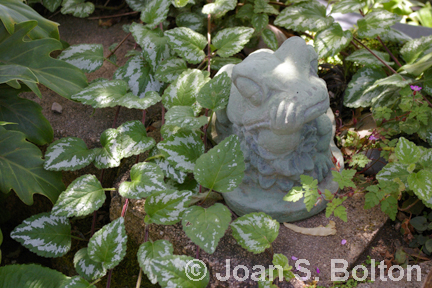
Who needs flowers?
Try to liven up a shady spot in your garden, and your list of ever-blooming plants is likely to be woefully short.
But shift your focus to foliage plants, and you’ll enter a world of year-round color.
Along with many shades of green, you’ll find leaves in yellow, orange, red, pink, purple and white. You’ll see speckles, swirls and stripes, and even some metallics.
These wild characters tend to like warm weather, so there’s a good selection at nurseries now. They include an assortment of annuals and perennials, although due to our mild weather, those that are labeled as annuals may behave as short-lived perennials, thriving for a few years before expiring.
Watering needs range from dry to wet. Most appreciate a monthly dose of fertilizer.
The following are among the best for crazy color right along the ground, or just above it.
Carpet Bugle (Ajuga reptans)
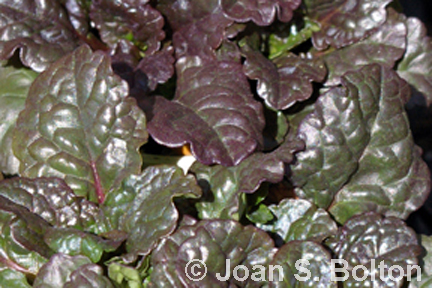
The straight carpet bugle is a classic, quiet, dark-green ground cover.
But the spinach-like, puckery leaves of Catlin’s Giant are bronzy red, and Black Scallop is dark purple.
Both creep along the ground and spread 2 to 3 feet wide. Short plumes of bluish-purple flowers rise another 6 to 8 inches above.
Be sure to bait for snails and slugs, which love to munch the leaves. It’s okay to let the plants can go dry between waterings.
Rex Begonias
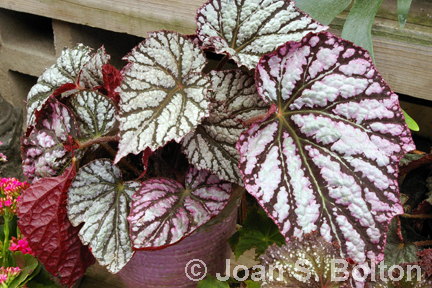
This class of begonias bears amazing patterns on large, crinkly, pointed leaves. Colors range from green to white to gray to burgundy, with a few metallic tones thrown in.
Rex begonias tend to be collector’s plants and can command high prices.
They’re best in pots or hanging baskets where you can admire all that value up close.
Keep the soil evenly moist and avoid watering from above, as the droplets can spot the leaves and lead to botrytis, a potentially deadly fungal disease.
Variegated Ground Ivy (Glechoma hederacea ‘Variegata’)
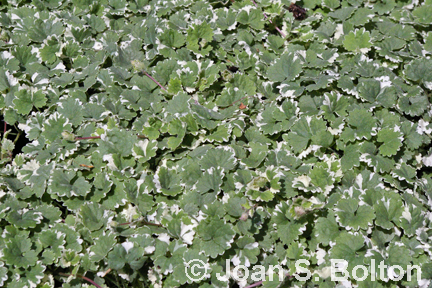
Don’t let the dainty, variegated leaves of this perennial fool you.
Just like its bigger namesakes, ground ivy traverses the earth via trailing stems that root and re-root. It grows only a few inches tall and is useful for covering small patches of poor soil.
But keep it away from your lawn, where it can become a nuisance.
It’s easier to control — and is quite fetching — in hanging baskets. Plant in cool sun or bright shade, and water about once a week during dry spells.
Variegated Licorice Plant (Helichrysum petiolare ‘Licorice Splash’)
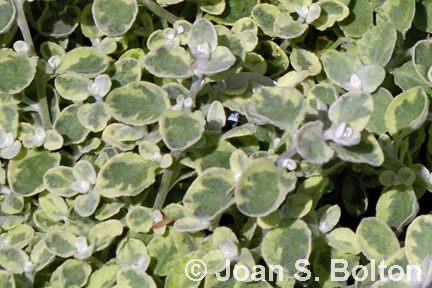
Fuzzy, multi-hued leaves in dark green, light green, yellow and silver densely cloak this charming perennial, while the long, slightly fuzzy branches gracefully arch and weave their way through other plants.
Licorice Splash is often recommended for containers.But because it grows at least a foot tall and spreads a few feet wide, I prefer growing it in the ground, where it has room to roam.
Water about once a week until your plants are established. Then let them go dry between waterings.
Coral Bells (Heuchera)
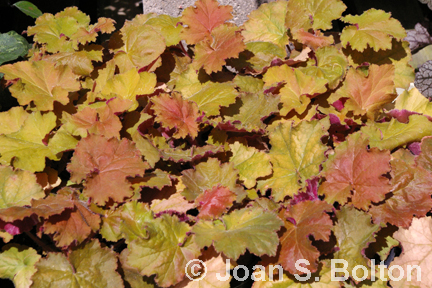
Plant breeders have gone nuts with these small, clumping perennials, creating a seemingly infinite number of color combinations in green, amber, yellow, purple and silver.
Look for Kassandra, which bears frilly, maple-like leaves in orange, yellow and red; Cathedral Windows, which bears purple leaves with puckery pink splotches; and Silver Scrolls, which bears larger, slightly cupped leaves that are silver with green veins and purple edges on top, and completely purple underneath.
Regardless of their coloring, coral bells are at their best with fast-draining soil and morning sun or all-day filtered light. Full sun or late afternoon sun can scorch the leaves.
Polka-Dot Plant (Hypoestes)
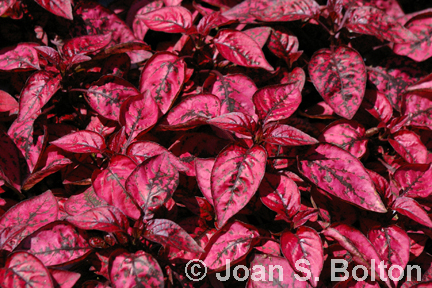
Bright, tropical pairs of leaves adorn this perennial. Splash Red is bright cherry red with splotches of olive green, while Splash Pink is hot pink with speckles of medium green.
Polka-dot plant is grown as a houseplant in most places, and it’s debatable as to whether it will overwinter on the Central Coast.
Your best bet is to grow it in a pot so you can bring indoors if temperatures drop. Water frequently, and pinch back the leaves to the nearest joint if your plant gets leggy.
New Guinea Impatiens
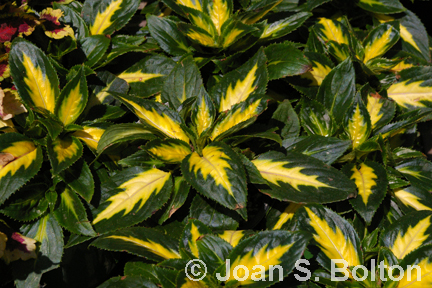
Standard impatiens are grown for their nonstop, colorful flowers: their small, nondescript green leaves have zero to do with their popularity.
But the New Guinea hybrids bear large, lush, tropical leaves with strong, contrasting patterns of green, white, yellow, coral, red and bronze. The flowers seem almost an afterthought.
Most of the hybrids grow 1 to 2 feet tall, and slightly wider. Their colors are brought out by bright, indirect light or not-too-intense morning sun. Keep the soil evenly moist.
Sweet Potato Vine (Ipomoea batatas)
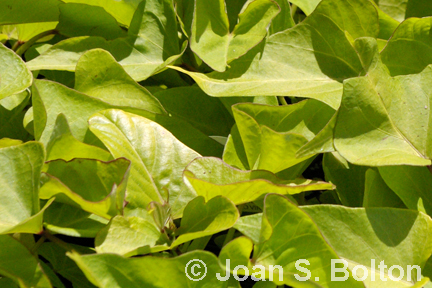
Who would have thought that the lowly edible tuber could be enticed into producing such decorative top growth?
Lush, heart-shaped leaves glow in opposing — yet complementary — shades of lime-green and purple.
The plants don’t actually vine — they have a trailing habit, and are better on the ground as a quick-growing cover, or in a container where they’ll spill over the side.
They grow fast during warm weather, and easily reach 3 feet wide by summer’s end. But in late fall, they collapse. And while they’re technically a perennial, I’ve not been able to resurrect mine for another go-round the following year.
Dead Nettle or Spotted Nettle (Lamium maculatum)
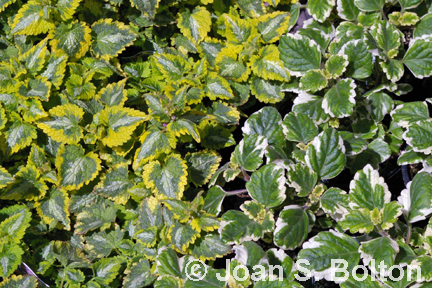
What a hideous name for such an appealing and versatile shade plant.
Trailing stems bear heart-shaped leaves that sport all sorts of patterns in green, yellow and silver.
Emeralds n’ Gold is green with a bright yellow edging and a silver stripe down the middle, while Pink Pewter is ghostly white with just a hint of green on the edges.
Dead nettles spread fast, but are easy to keep within bounds. They grow well in part to full shade, and appreciate evenly moist soil.
Coleus (Solenostemon or Coleus x hybridus)
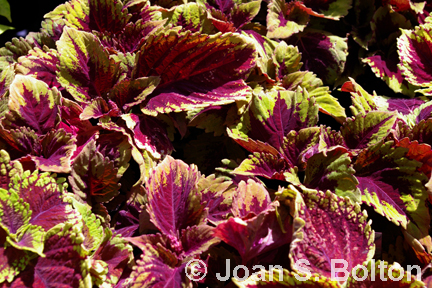
These tropical plants can be fussy to get right.
But wow!
Few other plants match the intensity of the foliage, which can include yellow, hot pink and fire-engine red on the same leaf.
Most coleus grow about 2 feet tall and wide, and are at their finest when out of the wind and in filtered light.
Too much sun and their colors may bleach out. Water once or twice a week and apply a high-nitrogen liquid fertilizer twice a month.
≈
Watering Your Foliage Plants
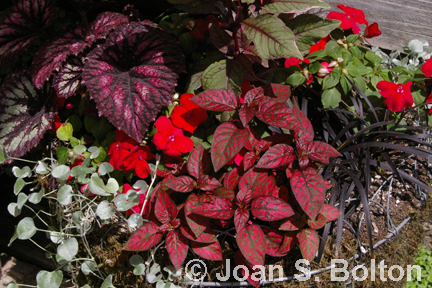
How your foliage plants spread will determine the best way to water them.
Conventional drip irrigation emitters are fine for plants that grow from a central stem.
But for those that re-root, use overhead sprayers or weave soaker tube through the planting bed to evenly water the area.
Early on, you may have to play with the frequency. Many shade plants require more water than sun lovers. But because they’re in the shade, the soil doesn’t dry out as quickly.
Watch closely to catch the plants just before they wilt significantly. Note the number of days that has elapsed, and then water a day or two earlier than that. As the plants gain size, try backing off on the frequency.
≈
Seeds of Wisdom
Hose off your foliage plants occasionally, to keep their colorful leaves looking fresh. Do so early in the day, so that the leaves have time to dry before cooler nighttime temperatures set in.
≈
Copyright, Joan S. Bolton. All rights reserved. Reproduction of text or photos in any form is prohibited without written permission.
≈
